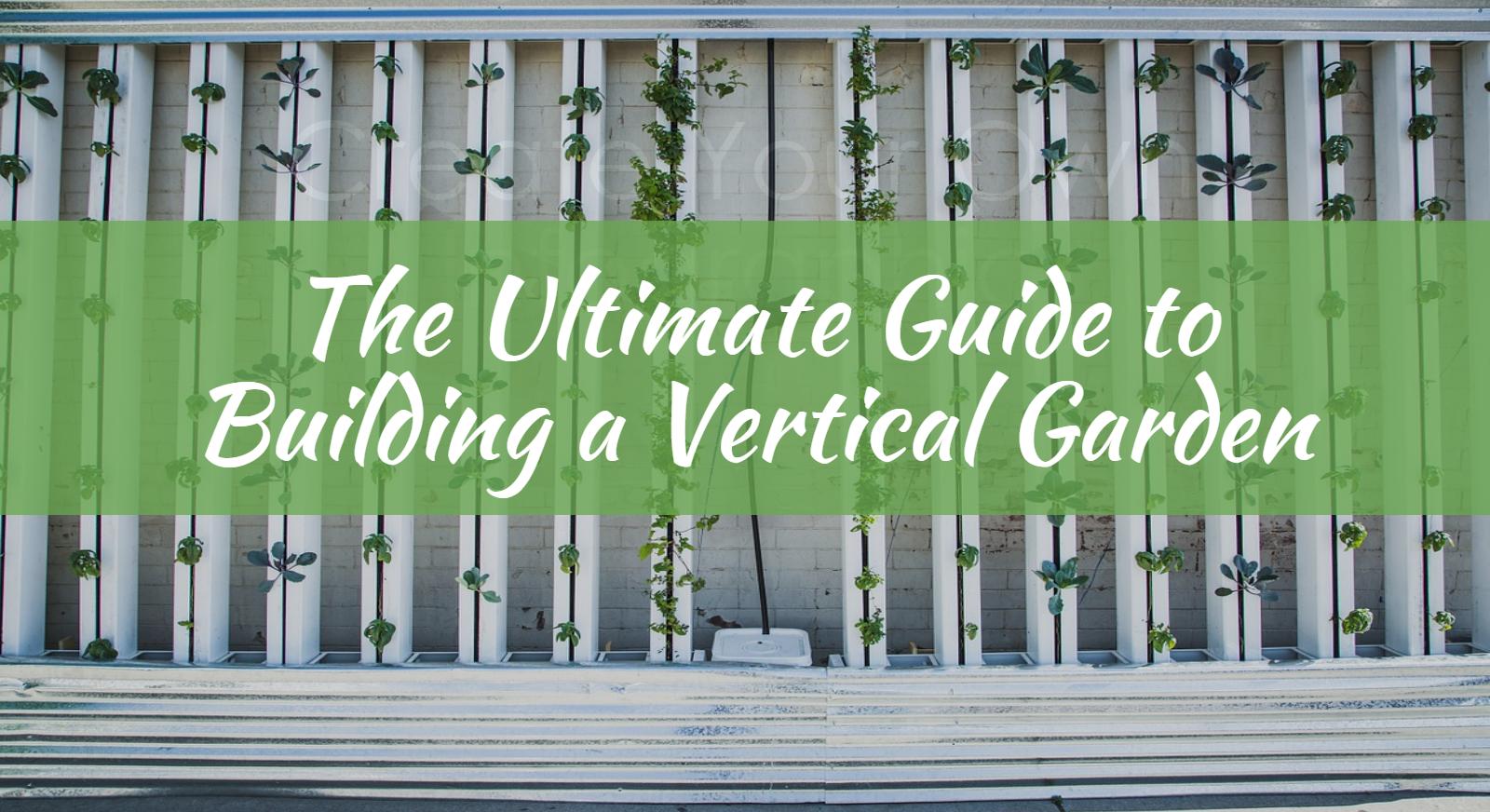We use cookies to make your experience better. To comply with the new e-Privacy directive, we need to ask for your consent to set the cookies. Learn more.
The Ultimate Guide to Building a Vertical Garden
At first glance, one might not think that small spaces and gardening are much of a match, but the revolutionary idea of vertical gardens is quickly changing that perception. When we say “nature”, “organic”, “herbs” or “vegetables”, we immediately think about large open spaces, bathed in sunlight, fields of green and enough land for tractors and ploughs. We also think about the countryside. But it doesn’t have to be like that.

The Ultimate Guide to Building a Vertical Garden
At first glance, one might not think that small spaces and gardening are much of a match, but the revolutionary idea of vertical gardens is quickly changing that perception.
When we say “nature”, “organic”, “herbs” or “vegetables”, we immediately think about large open spaces, bathed in sunlight, fields of green and enough land for tractors and ploughs.
We also think about the countryside.
But it doesn’t have to be like that.
Urban gardens or apartments have limited space available, but you can still grow flowers, herbs and vegetables, if you decide to set up a vertical garden.
And here is your ultimate guide to doing that, complete with logistics, all the practical and technical steps involved, space and time expectations, types of plants that can be cultivated and, of course, results.
Everything you need to know on how to grow your very own slice of nature on the terrace is right here.





The first thing which is of crucial importance for you to understand is that this will, most likely, take a lot of effort. Growing plants is not easy and even more so in the city, in a very confined space and in vertical position.
But don’t get discouraged and don’t give up. That’s the beauty of it.
Second of all, you have two options when deciding to build a vertical garden.
You can call in a specialist, like a botanist, an urban greening specialist or a bio wall designer, which will make your job very, very easy. He will do all the planning and the work and you will just have to take care of the wall afterwards.
Your other choice is to do it all yourself. And here is where you have to remember another important thing. You will learn how to do it properly through a more or less extensive trial and error process. There are books that can teach you, but experience will be your best professor.
And while on the subject of books, here are some that will definitely outline and guide you through the whole process.

Books to Check Out
- Garden Up! Smart Vertical Gardening for Small and Large Spaces by Susan Morrison and Rebecca Sweet – it has design ideas, tips on how to build in over 200 pictures which will help you to better visualize the steps and the final format.
- The Vertical Garden: From Nature to the City, by Patrick Blanc – he is considered to be the inventor of the vertical garden, so tips from him are extremely welcomed. He has created green vertical spaces all around the world, including the aquarium in Genoa, the Quai Branly Museum in Paris or the Siam Paragon mall in Bangkok.
- Vertical Gardening: Grow Up, Not Out, for More Vegetables and Flowers in Much Less Space by Derek Fell. What’s interesting about this book is the fact that its author has tried and actually tested thousands of different types of vegetables, flowers and fruits and he is now able to recommend the best climbing plants, as well as the ones which are less prone to diseases or attacks from insects and animal pests.
- The Vertical Gardening Guidebook: How To Create Beautiful Vertical Gardens, Container Gardens and Aeroponic Vertical Tower Gardens at Home by Tom Corson-Knowles. Just as the title suggests, this your helper when it comes not just to vertical gardens, but container and aeroponic ones as well.
- Urban Gardening: How To Grow Food In Any City Apartment Or Yard No Matter How Small by Will Cook. Here we have a guidebook on how to specifically grow edible plants and vegetables in the city, in small indoor spaces, like apartments.
An important aspect you have to take into consideration is research.
It is the key to a successful growth. Make sure you read all you can find online, buy books and look at pictures and tutorials on websites such as Pinterest. Know what you’re getting into.
Indeed, growing flowers, salad or pumpkins looks pretty and bohemian, but there are a lot of aspects you need to take into consideration prior to starting, such as: added costs to your water bills, the fact that a lot of time has to be invested into taking care of the garden, as well as all the actual physical work you are going to have to put in. Research and reading can help you figure all this out and tell you if home gardening is actually for you or not.
After the research is complete and you have decided you want to build a vertical garden in your home, there some logistic questions you need to ask yourself, in order to be able to get started correctly. Here they are.

FAQ
#1. What do you want to grow?
There are many types of vertical gardens: flower, vegetable, herb, or fruit, but this is the most important thing, figuring out what exactly it is you want to get from it, because all other related things stem from this answer.
And while it’s true that most people dream about having their very own vegetable patch and fresh produce and herbs every day, it might be taxing.
Therefore, if you are not sure you can afford the time for taking care of tomatoes, squashes or cucumbers, you might want to redirection your efforts towards herbs or flowers, which require a lot less tending to.
#2. Ask yourself if this is worth it.
As mentioned previously, tending to a vertical garden means channelling a lot of resources from you part, such as time, money and manual labour.
The results will depend on your limited amount of space. Research is the key to answering this question as well. Try to find some factual data regarding harvest amounts, depending on the square footage of the garden you would like to have.
One such example is of a grower in California who, from a 5 by 20 foot section, in the timeframe of one year and growing vegetables and herbs such as tomatoes, bell peppers, zucchinis, basil and lettuce, managed to produce £500 worth of greens.
As far as costs go, this California grower first of all spent eight hours preparing the space, which means digging, amending the soil and raking it smooth, placing the stepping stones, digging the holes, adding the fertilizer, and actually setting the plants and the appropriate seeds into the ground.
After that, the young plants needed to be watered by hand for a few weeks, because they were too small to reach the irrigation set in place in the garden. 30 minutes of hand watering seemed to do the trick for this vegetable lady in California.
As for the rest of the season, she had to tie the tomatoes and the peppers to their stakes, twig the uneven branches and harvest the produce. She estimates she spent an hour and a half each week doing this.
So, this is a good example of the kind of research you need to do and see if the physical work and the time spent doing it in relation to the results are worth it for you.
#3. Where will you set it up?
Another important logistical step before you actually start building and planting, is to determine where you will set up your vertical garden. So here are some criteria to help you decide:
- Determine whether the vertical garden will be inside your house, outside in the garden, on the lawn, on the terrace, on the balcony or if you want to build a sun room for it.
- Think about your neighbours, if you live in an apartment, as you might cause some nuisance.
- Think about where exactly your terrace, balcony or garden is located in relation to the sun, because the plants will need as much sunlight as possible, so if, for example, you terrace is on the north and doesn’t get much direct sunlight, you might not have the results you expected.
- Remember that the vertical garden will be planted against a wall of your house, so don’t pick one with a window or that has a window very close to it. All the bugs and pests from the garden will crawl inside the house.
- Think about the irrigation system you need to put in place and how you can set that up in relation to the water pipes inside the house. Make sure not to flood your neighbours.
All these little details need careful planning for everything to go well, so it might be a good idea to call in a specialist at first to help you out.

How Much Does it Cost?
The good news is that they are inexpensive. There are several types you can try, such as PVC, wood, metal or plastic, but none of them are actually pricy.
An outside vertical garden can cost somewhere between £40 and £200. But internal gardens will be more expensive because of the special watering system you need to put into place and because you will have to waterproof the area.
In any event, as far as costs go, the rule is simple, the bigger and more elaborate a garden you want to grow, the pricier it will be.

Another simple thing to remember here, a DIY garden will always be cheaper than one designed and erected by a specialist.
Don’t be afraid to do it yourself, it’s not difficult, buy the necessary books or find the right tutorials on the internet, which will guide you through a step-by-step easy process.
These are the main questions you need to answer before actually getting to work. Once you have all the information you need, it’s time to start building.
Here are all the technical and practical steps involved in building an actual vertical garden, in detail.

Building your Vertical Garden
Choose a Wall
This step was mentioned before, but it’s very important.
You should know that it doesn’t matter if the wall is load bearing or not, so don’t waste your time trying to dig up blueprints of the house or building you live in.
The plants themselves will be supported by the racks you’re building, which will lean gently on the wall, but not actually transfer any of the weight.
What you should think about when choosing a wall is water and pest damage to it.
Also, sunlight.
Try choosing that particular wall that usually receives most sunlight.
Also, from an aesthetic point of view, if you have a wall that, let’s say, ugly, this is your chance to cover it up easily.
Build the Frame
Taking Patrick Blanc’s advice and building one of his classic vertical gardens, you will find out that a vertical garden is made of three layers, closely attached together, meaning the frame, the plastic sheeting and the fabric.
An important mention is that you build the whole structure before you actually hang it, because it will be easier and faster this way. It is possible to attach the installation directly to the wall, but building a frame first and attaching it to that will make it easier for you take down.
Patrick Blanc’s advice is to use PVC pipes for the frame itself.
They are sturdier and cheaper, as opposed to metal, which is significantly more expensive and adds a lot more weight. Wood is also a worse idea than PVC, because it needs pressure treating as far as water protection goes.
First of all because water trapped between the wood wall and the frame’s plastic is not a good idea and second of all because wood rots.
You can handcraft the frame yourself, using ¾ inch PVC pipes, some elbows and four-way joints. Buy some tools and kits from your hardware store.
Other than that, you could also use a system of wooden stacked vertical garden planters.
Add the Plastic Sheeting
Use expanded PVC sheets, which will act a back-up for the layer of fabric, and which is easy to attach. However, if you want to put it on a wood wall instead of a PVC one, you will need to ventilate behind.
Add the Fabric
Be careful to attach it firmly and safely to the frame, as this is the actual layer in which your plants will be seeded and grow and which will hold the water they need.
One example of material is felt carpet padding, but, according to Patrick Black, you can use any material, as long as it holds water but doesn’t rot at the same time.
Keep in mind a few things here:
- - Two layers at least will be needed
- - They need to be attached directly to the frame with galvanized screws and stainless-steel staples
- - Make sure they don’t have any wrinkles or creases
- - Attach it firmly so that it doesn’t fall off when the vegetables are big and heavy
- - Try, if possible, to make it look aesthetically pleasing.
This is very important and you cannot skip it.
It’s not possible to water vertical gardens manually, like classic, horizontal gardens. You will need some sort of irrigation system that will keep the fabric and, therefore, the plants, moist at all times.
The best way to approach this step is to call in a specialist or even a plumber.
Even if you are in the middle of your biggest DIY project, bring in someone to help you, because you could easily do it wrong and parch your plants or end up flooding your house or your neighbours.
Don’t forget to link your hydroponic gardening installation to your main watering system and to filter it, because tap water is not good for growing plants.
But a filter is cheap and you can buy the kit at your local hardware store or depot.
Also, there will be some leakage, no matter what you do, at the bottom of the garden. So either you’re alright with it and let it dry on its own, or you plant some flowers or some ferns directly below the structure, for all the excess water to go to.

Add the Fertilizer Injector
You will need to fertilize your plants all year long and, in order to make this process more efficient time-wise and to spare you some manual work, add a fertilizer injector to your system.
It will sprinkle liquid fertilizer on the plants.
Choose the Plant
If you followed the logistic steps laid out for you at the beginning of this guide, you will know by now if you’re growing vegetables, fruit, herbs or flowers.
However, even if you have decided on the main category, there are still things to take into consideration.
So, let’s say, for example, you have set your mind on vegetables. You still need to do some research and find out which are the best vegetables to be cultivated in your geographical area or which are the best for growing in a vertical garden.
Read below for a detailed description of the particular types of vegetables, fruits and flowers best suited for this type of cultivation.
Also, when choosing exactly what plants to grow, think about factors such as sunlight, shade, humidity, wind, how prone your region is to hurricanes, how cold does it get in the winter and how hot in the summer.
It’s important to understand that, even if you want a certain type of vegetable or fruit, they cannot be cultivated everywhere.
The Planting
Make a small horizontal cut with a sharp knife in the fabric of the installation.
Thoroughly clean the plants root of any soil, mud, gunk or debris it might have on it, in order to keep it from rotting. Insert it into the slit you just made.
The last step is to attach (preferably staple) the fabric to the plastic back, in a not too tight, but close enough semi-circle, in order to create a stable and protective envelope around the bulb.
Work on the Design
Here you have endless possibilities, when taking the vertical garden DIY approach, so go online and search for designs or use your own imagination.
If you are growing decorative plants or flowers, it will be easy to give your vertical garden any shape you want, but keep in mind vegetables are heavy.
And, last but not least, if all these steps seem to be too much for you, call in a specialist.
There’s nothing wrong with that. They will set up everything and leave you to do only the actual gardening and harvesting. And you can still call it a DIY vertical garden if you want.

What Should you Grow?
Let’s discuss now the types of plants best suited to be grown in a vertical garden. There are the four main categories, vegetables, fruit, flowers and herbs, and here are the best items to choose from.

Vegetables
Growing vegetables is definitely the most rewarding out of all the categories.
There’s nothing quite like seeing the beautiful produce grow in front of your eyes in your very own vertical vegetable garden.
Watch the tomatoes redden under the hot sun, the squashes turn a beautiful, buttery yellow or orange, or the cucumbers come to life in vibrant, cold, elongated greens. It is a lot more hard work than with the other categories, but the feeling is incomparable.
The produce will be also fresh, ripe, organic and, as you will definitely notice, a lot tastier than the store-bought brands. Here’s what to grow:
- Beans – these vegetables are perfect because they require poles and height in order to grow by default, which means they will thrive in a vertical environment. Remember to water them constantly, because they do not respond well at all to draught. A specific type you can try are pole beans.
- Tomatoes – definitely everybody’s favourite, they will prove easy to grow and very, very tasty. Not to mention the beautiful sight they are while ripe and still not picked, turning the landscape into a vertical succulent garden. Remember to tie them to the frame, because the fruits are very heavy.
- Cucumbers – the same as with beans, all types of cucumbers grow on vines, so this makes them great for growing in a vertical garden. You can choose any variety you want. The smaller ones are good for pickling, while the larger ones grow fruits that are straighter and more uniform, if this is what you’re interested in.
- Vine squash – they require a firm rack, which can handle the weight. You can also plant these first, at the bottom of your vertical garden. In this way, you will also be able to insert a miniature trellis for each fruit in particular, which will support its weight.

Fruit
Indeed, the range is not large here.
As we all know, the vast majority of fruits grows in trees and you cannot accommodate them in a vertical garden.
However, there are some types you can try growing:
- Strawberries. The tasty, enticingly sweet and amazingly smelling fruits are an easy harvest for living walls. They root easily and have high endurance to weather conditions. If you plant them up high and let them hang down, they will create a beautiful, colourful effect. Also, it keeps them away from slugs, which like to feast of their sweet flesh, but you must keep an eye out for birds, which will be attracted to them. Apart from that, the best solution to grow strawberries vertically is to build a hydroponic garden tower, out of a large PVC pipe, with holes in it. Wall planters work just as well, with the strawberries cascading down from them.
- Melons – they belong to the same family as cucumbers and squash, therefore growing them will be exactly the same. They require a lot of support, because, in the same way, the fruits are very heavy, so you might want to plant them on the bottom row of the green wall next to their brothers the squashes. Lend them a helping hand with some poles on which their vines to twine or simply allow the fruit to rest on the ground, as they do in nature. Pallet or planters are also a good idea as far as frame systems go. Melons also require a lot of water. Remember, all the cucurbits are made mostly out of water, so they need plenty of it. The same way they need a lot of sun to ripen and become deliciously sweet.
- Berries – in the same way you grow strawberries, you can also grow the rest of their family members. Use racks or frames, or even the hydroponic tower mentioned for strawberries. The growing method is exactly the same. They are all delicious, healthy and packed with antioxidants.

Herbs
There’s nothing better than cooking a home-made meal with herbs you’ve only just collected from your vertical herb garden.
Fresh basil and oregano and big, crunchy salad or spinach leaves make your heart grow twice its size.
So why not give them a try?
You can grow them in vertical garden planters, in indoor vertical gardens, because they are small and even in hanging gardens, making rows upon rows of great smelling herb pots.
You can set the pots in pallets, if you are building a pallet herb garden.
The good thing about trying the herb variation of the vertical garden is that you can grow virtually any type: basil, thyme, oregano, sage, chives, cilantro, tarragon, rosemary, spearmint, dill, marjoram, parsley… add some lavender here and there for a splash of colour in the at sea of green and you have provence at your back door and in a living wall planter.
Remember to label them all.
Insert little wooden signs in the soil itself or in the herb planter and add tags.
You can consume them all fresh, or you can dry them up, which will make your house smell amazing for weeks and create your very own complete spice rack.
Then you can start making delicious focaccia every day!

Flowers
This type of vertical garden has a decorative purpose, mostly.
There are some flowers which you can actually eat and you can do some research and insert those ones as well. For the rest, just like with vegetables, there are specific types which are fitted for growing in the city in a wall garden, and some which are not, like, for example, orchids.
But, if you want to stick to the basics and create a wall of pure, natural, flowery perfection, here are the best:
- Geranium. It’s one of the most beautiful garden flowers out there. They are also called Crane’s Bill and the flowers themselves come in big, outstanding pink or red balls. Some hybrid species also exit, which render white or purple flowers. Because they are big, bold and bright, geraniums are sometimes used for wedding bouquets.
- Bromeliads. They look and sound exotic and literary, thanks to Terry Pratchett’s novels that were named after them. What makes them perfect for vertical cultivation is that they naturally need very little soil to grow in, produce long lasting flowers and they have colourful and appealing leaves. Many species exist, so make sure to choose a wider variety of bromeliads for your garden.
- Begonias are sweet and delicate and they have an interesting foliage as well as eye catching flowers. The good thing about begonias is that they produced a long list of hybrids, some of which thrive in the shade, while others long for the sun. This means you can adapt them to your needs and not take into consideration your local weather conditions. Also, just like the bromeliads, they flower for a very long time.
- Hoyas are natural climbers, a quality that makes them attractive to home vertical garden owners. They will love and thrive on the frame you’ve erected for them. They love the indoors as much as the outdoors, so they shelter in any space you might choose to place your garden. They have white or pink flowers that are very interesting, because they look like cotton, are shaped like stars, with beautiful little middles, which are also shaped like a star, making this flower a veritable geometrical matryoshka doll. One particularly amazing Hoya hybrid comes in gun metal grey flowers with striking red middles. But you should know they are classified as rare flowers.
- Don’t forget to add some green to all this color. You can plant rows of ferns, but keep in mind ferns need shade, humidity and a colder weather temperature or you can plant Baby’s tears. Also known as helxine, it too loves shade and moisture, exactly like the ferns, so plant them at the bottom of your installation.

And That's It!
So there you have it.
The ultimate guide for your vertical gardening needs. Don’t be scared of the work you have to put into all this, because the results will be amazing.
Picking red ripe tomatoes with your own hands from the vines and splashing them on a plate, making a strawberry pie with organic and tasty fruit you’ve just picked from your own garden or reading a book in the shade of your flowery natural wall is a well-deserved and fully rewarding return to nature in the middle of the crowded city.
